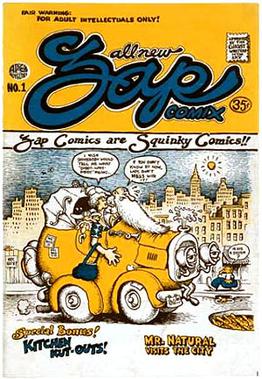
Underground comix are small press or self-published comic books that are often socially relevant or satirical in nature. They differ from mainstream comics in depicting content forbidden to mainstream publications by the Comics Code Authority, including explicit drug use, sexuality, and violence. They were most popular in the United States in the late 1960s and 1970s, and in the United Kingdom in the 1970s.
A graphic novel is a long-form work of sequential art. The term graphic novel is often applied broadly, including fiction, non-fiction, and anthologized work, though this practice is highly contested by comics scholars and industry professionals. It is, at least in the United States, typically distinct from the term comic book, which is generally used for comics periodicals and trade paperbacks.

Alternative comics or independent comics cover a range of American comics that have appeared since the 1980s, following the underground comix movement of the late 1960s and early 1970s. Alternative comics present an alternative to mainstream superhero comics which in the past have dominated the American comic book industry. Alternative comic books span a wide range of genres, artistic styles, and subjects.

An American comic book is a thin periodical originating in the United States, on average 32 pages, containing comics. While the form originated in 1933, American comic books first gained popularity after the 1938 publication of Action Comics, which included the debut of the superhero Superman. This was followed by a superhero boom that lasted until the end of World War II. After the war, while superheroes were marginalized, the comic book industry rapidly expanded and genres such as horror, crime, science fiction and romance became popular. The 1950s saw a gradual decline, due to a shift away from print media in the wake of television and the impact of the Comics Code Authority. The late 1950s and the 1960s saw a superhero revival and superheroes remained the dominant character archetype throughout the late 20th century into the 21st century.

"Omaha" the Cat Dancer is an erotic comic strip and later comic book created by artist Reed Waller and writer Kate Worley. Set in fictional Mipple City, Minnesota in a universe populated by anthropomorphic animal characters, the strip is a soap opera focusing on Omaha, a feline exotic dancer, and her lover, Chuck, the son of a business tycoon.

Kitchen Sink Press was a comic book publishing company founded by Denis Kitchen in 1970. Kitchen Sink Press was a pioneering publisher of underground comics, and was also responsible for numerous republications of classic comic strips in hardcover and softcover volumes. One of their best-known products was the first full reprint of Will Eisner's The Spirit—first in magazine format, then in standard comic book format. The company closed in 1999.

Trina Robbins is an American cartoonist. She was an early participant in the underground comix movement, and one of the first female artists in that movement. She is a member of the Will Eisner Hall of Fame.

Denis Kitchen is an American underground cartoonist, publisher, author, agent, and the founder of the Comic Book Legal Defense Fund.
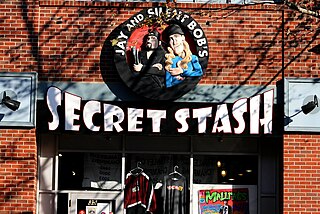
The direct market is the dominant distribution and retail network for American comic books. The concept of the direct market was created in the 1970s by Phil Seuling. The network currently consists of:

Jay Patrick Lynch was an American cartoonist who played a key role in the underground comix movement with his Bijou Funnies and other titles. He is best known for his comic strip Nard n' Pat and the running gag Um tut sut. His work is sometimes signed Jayzey Lynch. Lynch was the main writer for Bazooka Joe comics from 1967 to 1990; he contributed to Mad, and in the 2000s expanded into the children's book field.
Jay Kinney is an American author, editor, and former underground cartoonist. Kinney has been noted for "adding new dimensions to the political comic" in the underground comix press of the 1970s and '80s.

Michael Terry Gilbert is an American comic book artist and writer who has worked for both mainstream and underground comic book companies.
Roger Sabin is an English writer about comics and lecturer at Central St. Martins in London, England.
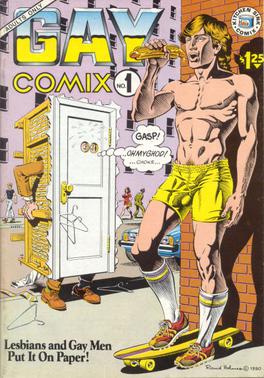
Gay Comix is an underground comics series published from 1980–1998 featuring cartoons by and for gay men and lesbians. The comic books had the tagline “Lesbians and Gay Men Put It On Paper!”
The Hornet was a British boys' comic published by D. C. Thomson & Co. for 648 issues from 14 September 1963 to 7 February 1976, after which it was merged with The Hotspur. The free gift with the first issue was a balsa wood "Kestral Glider".
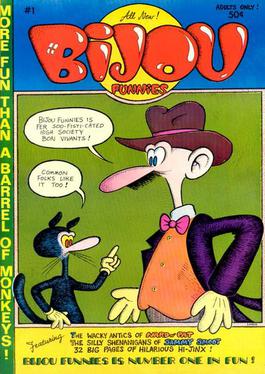
Bijou Funnies was an American underground comix magazine which published eight issues between 1968 and 1973. Edited by Chicago-based cartoonist Jay Lynch, Bijou Funnies featured strong work by the core group of Lynch, Skip Williamson, Robert Crumb, and Jay Kinney, as well as Art Spiegelman, Gilbert Shelton, Justin Green, and Kim Deitch. Bijou Funnies was heavily influenced by Mad magazine, and, along with Zap Comix, is considered one of the titles to launch the underground comix movement.

Tits & Clits Comix is an all-female underground comics anthology put together by Joyce Farmer and Lyn Chevli, published from 1972 to 1987. In addition to Farmer and Chevli, contributors to Tits & Clits included Roberta Gregory, Lee Marrs, and Trina Robbins.
Leonard Rifas is an American cartoonist, critic, editor, and publisher associated with underground comix, comics journalism, left-wing politics, and the anti-nuclear movement. He is notable for his contributions to the form of minicomics as well as publishing Japanese manga in the United States. Rifas' publishing company, EduComics, operated most actively from 1976 to 1982.
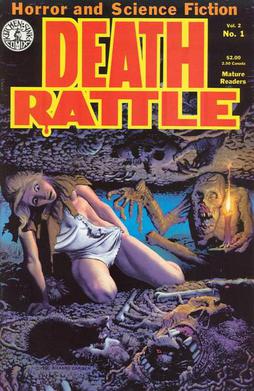
Death Rattle was an American black-and-white horror anthology comic book series published in three volumes by Kitchen Sink Press in the 1970s, 1980s, and 1990s. Death Rattle is not related to the Australian one-shot comic Death Rattle, published by Gredown in c. 1983.














